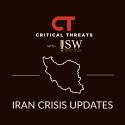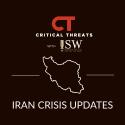Iran Crisis Update, November 6
Nov 6, 2022 - ISW Press
The regime continued linking the ongoing protests with terrorism on November 6 as part of an information operation to delegitimize protesters and their grievances. Parliament Speaker Mohammad Bagher Ghalibaf accused the US and Israel of stoking the protests to create a new ISIS in Iran. A group of 227 parliamentarians signed a letter similarly blaming the US for the unrest and comparing protesters to ISIS militants, calling for harsh and rapid prosecutions. Islamic Revolutionary Guards Corps (IRGC) Telegram channels previously characterized protesters as ”domestic ISIS” on November 3, as CTP previously reported.








